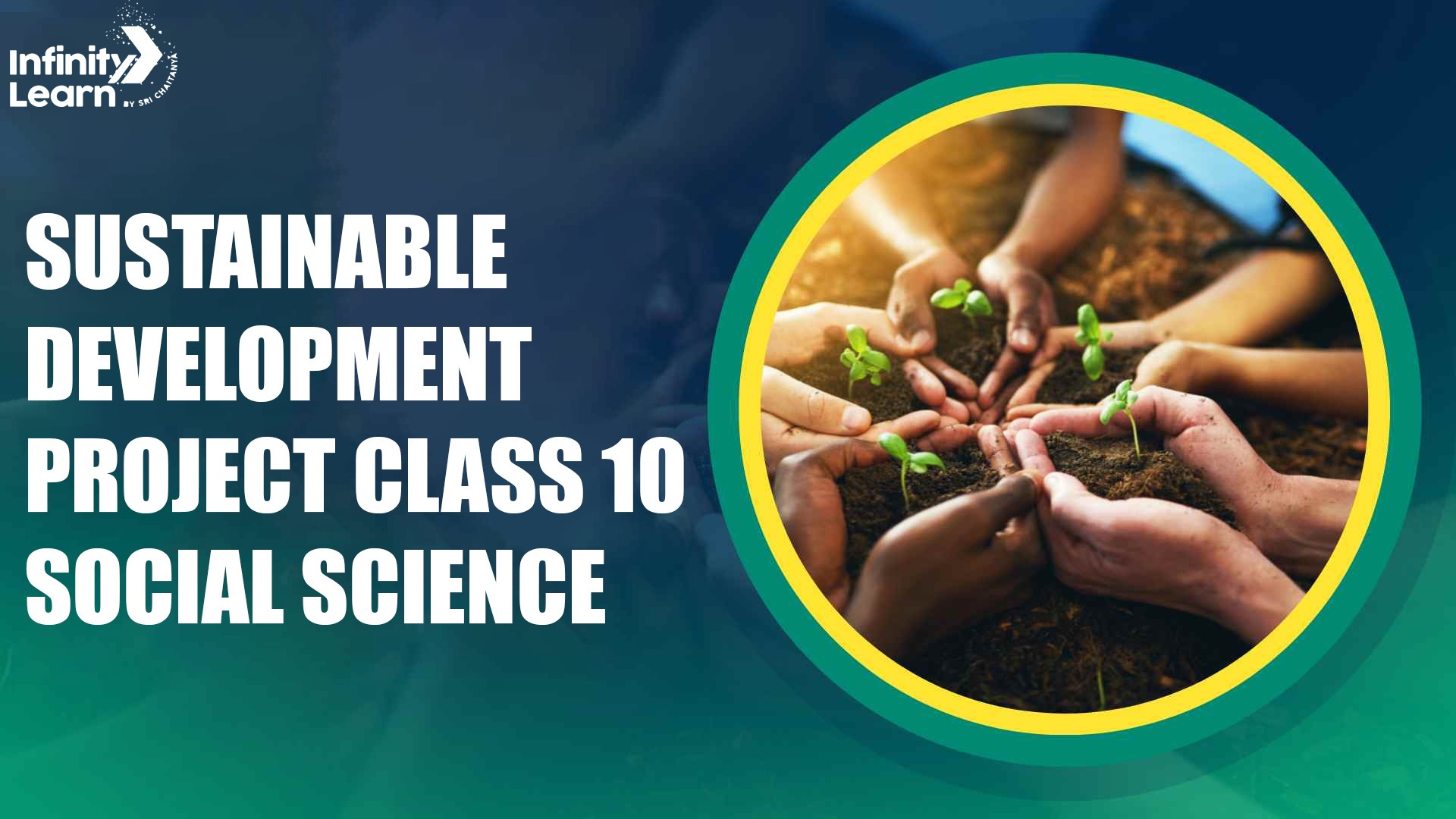Table of Contents
Sustainable Development Project Class 10: As part of the CBSE 2025–26 syllabus, Class 10 students need to prepare and submit Social Science projects focused on Sustainable Development. Infinity Learn is here to provide you various aspects of this project.
Here, you can find creatively designed Sustainable Development Project Class 10 pdf with cover images, beautifully crafted acknowledgment pages, and step-by-step guides on project planning, innovative ideas for research topics, and tips for creating impactful presentations. This comprehensive collection aims to inspire and support students in creating projects that effectively address sustainable development issues.

Understanding Sustainable Development
Sustainable development, defined by the Brundtland Commission in 1987, means development that meets the needs of the present without compromising the ability of future generations to meet their own needs. This principle urges us to use resources responsibly to maintain ecological balance.
Today, the United Nations Sustainable Development Goals (SDGs) provide a global framework with 17 goals aimed at tackling poverty, inequality, climate change, and environmental degradation. Students can align their projects with relevant SDGs to make their work globally meaningful.
Related:
What is a Sustainable Development Project for Class 10?
This project focuses on raising awareness and proposing practical solutions to promote economic growth, social equity, and environmental protection simultaneously. Students explore topics such as:
- Renewable energy
- Waste management
- Water conservation
- Sustainable agriculture
- Climate change impact
Through research and creative presentations, students learn how sustainable practices ensure a better future for all.
Steps to Create a Sustainable Development Project
- Choose a Topic- Select a topic that interests you and has a significant impact on sustainable development. Examples include renewable energy, waste management, water conservation, sustainable agriculture, and climate change.
- Research- Ensure to gather information from credible sources like books, academic journals, official government reports, and reputable websites to ensure accuracy and reliability.. Understand the current challenges and solutions related to your chosen topic.
- Set Objectives- Define clear objectives for your project. What do you aim to achieve? For instance, if your topic is water conservation, your objective might be to reduce water usage in your school by 20%.
- Develop a Plan- This might include conducting surveys, organizing awareness campaigns, implementing practical solutions, and monitoring progress.
- Implementation- Put your plan into action. Work with classmates, teachers, and community members to execute your project. Ensure that you follow sustainable practices throughout the process.
- Evaluate and Reflect- Assess the outcomes of your project. Did you achieve your objectives? What challenges did you face, and how did you overcome them? Reflect on what you learned and how the project can be improved in the future.
Sample Sustainable Development Project: Water Conservation in School
Topic: Water Conservation
Objective: Reduce water usage in the school by 20% within six months.
Research:
- Understand the current water usage in the school.
- Identify areas where water is wasted.
- Explore water-saving technologies and practices.
Plan
- Conduct a water usage audit to identify areas of excessive use.
- Install water-saving devices such as low-flow faucets and dual-flush toilets.
- Educate students and staff about water conservation practices through workshops and posters.
- Set up a system to collect and use rainwater for gardening and cleaning purposes.
- Monitor water usage monthly and adjust strategies as needed.
Implementation
- Collaborate with the school’s administration to get approval and support.
- Form a team of students to help with the audit and installation of devices.
- Organize educational workshops and create informative posters.
- Install the water-saving devices and set up the rainwater collection system.
- Regularly monitor and record water usage.
Evaluation and Reflection
- Compare water usage data before and after the project implementation.
- Analyze the effectiveness of different strategies.
- Collect feedback from students and staff.
- Document lessons learned and suggest improvements for future projects.
Outcome
- Successfully reduced water usage by 25%.
- Increased awareness about water conservation among students and staff.
- Created a model that can be replicated in other schools.
Bibliography
- Brundtland, G. H. (1987). Our Common Future. World Commission on Environment and Development.
- Environmental Protection Agency. (2020). Water Conservation Tips. Retrieved from EPA
- Jones, A. (2018). Sustainable Schools: Implementing Eco-friendly Practices. Academic Press.
Viva Questions
What is sustainable development, and why is it important?
Why did you choose water conservation as your project topic?
How did you conduct the water usage audit in your school?
What were some of the challenges you faced during the implementation of your project?
Can you explain the water-saving technologies you used in your project?
Tips for an Effective Sustainable Development Project
- Start early and manage your time well
- Use visuals like charts and posters for presentations
- Include real data and case studies
- Engage your audience with stories or interviews
- Practice answering possible viva questions confidently
Conclusion
A sustainable development project is an enriching experience that teaches students about the importance of sustainability and how they can make a positive impact. By following the steps outlined in this blog and drawing inspiration from the sample project, Class 10 students can create meaningful projects that contribute to a more sustainable future.
Sustainable Development Project Class 10 FAQs
What is the aim of a sustainable development project for Class 10 students?
The goal is to educate students on the critical balance between environmental conservation, economic development, and social justice. It encourages them to think critically about sustainability issues and take practical actions to make a positive impact in their communities.
How does sustainable development contribute to society?
Sustainable development ensures responsible use of resources, safeguarding them for the well-being of future generations. It promotes economic growth while protecting the environment and improving the quality of life by reducing pollution, conserving natural habitats, and fostering social equity.
What is the scope of sustainable development?
The scope of sustainable development includes: Environmental protection: Conserving natural resources and reducing pollution. Economic growth: Promoting green technologies and sustainable business practices. Social equity: Ensuring fair distribution of resources and opportunities.
What are some examples of sustainable development projects?
Some examples of sustainable development projects are Water conservation initiatives, Recycling and waste management programs, Renewable energy projects, such as installing solar panels. Sustainable agriculture practices like organic farming. Community awareness campaigns on environmental issues.
How do I choose a topic for my sustainable development project?
Choose a topic that interests you and addresses a significant issue in your community or school. Consider areas where you can make a measurable impact, such as reducing water usage, increasing recycling rates, or promoting renewable energy.








